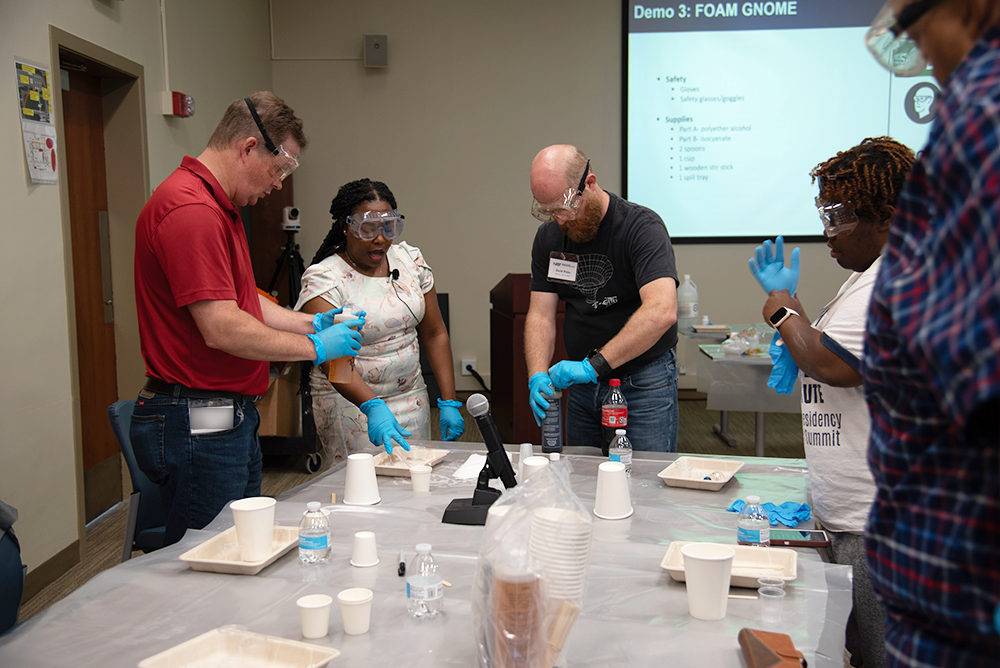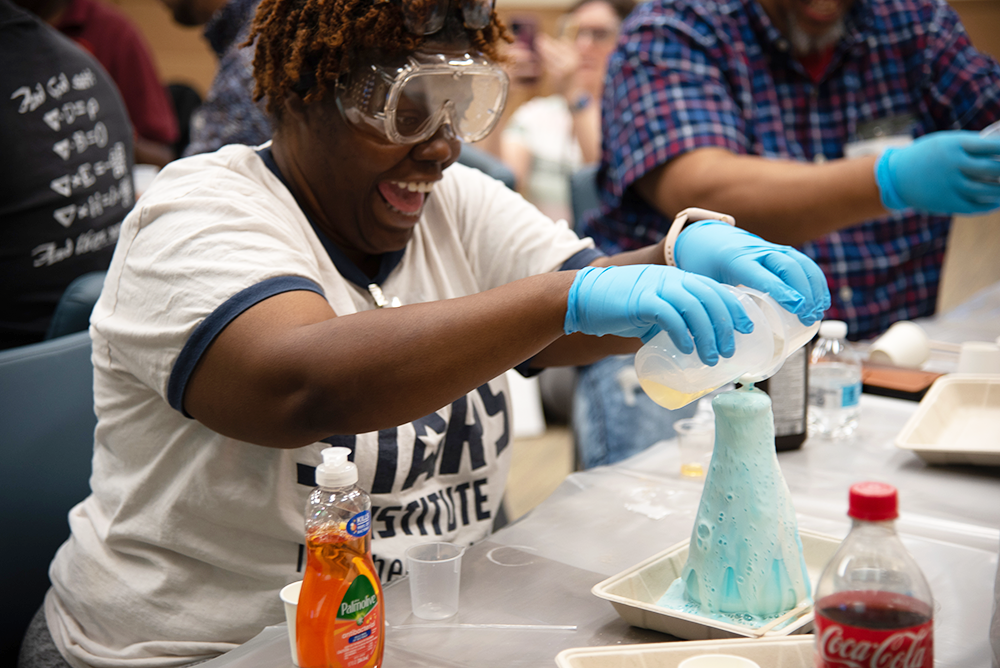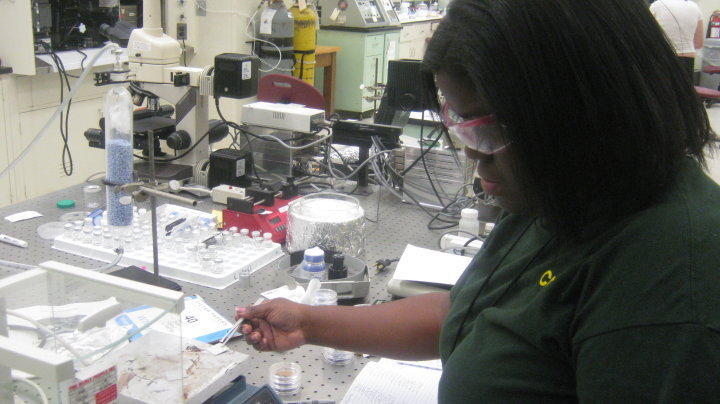Our PROMISE: Quality Digest only displays static ads that never overlay or cover up content. They never get in your way. They are there for you to read, or not.
Quality Digest does not charge readers for its content. We believe that industry news is important for you to do your job, and Quality Digest supports businesses of all types.
Middle school is the perfect time to plant the seed for a child to grow a lifelong love of science. That’s why I love being a middle school teacher.
While I know these experiments are valuable, my school doesn’t have much of a budget for science experiments. I spend my own money on supplies for many of my experiments. NIST sent many supplies from the experiments we did in this experience back home with us, and that will be helpful in my classroom.
Published: Thursday, October 19, 2023 – 12:03
.png)
NIST Summer Institute teachers make “elephant toothpaste” during an experiment they can use to teach their students about chemical reactions. In this experiment, hydrogen peroxide serves as the oxidizing agent and decomposes into water and oxygen. Credit: B. Hayes/NIST

Taylor (right) and other NIST Summer Institute participants watch a science experiment demonstration led by NIST’s LaKesha Perry (second from left). Program participants do hands-on demonstrations and hear briefings from NIST researchers over two weeks, both at NIST’s campus in Gaithersburg, Maryland, and online from around the country. Credit: B. Hayes/NIST
I especially enjoyed learning more about the research behind the building blocks of plastic, known as polymers. There are different instruments to test various polymer properties, such as their elasticity. I can reproduce this in my class using simple machines for my students.
The NIST Summer Institute was an excellent program and really builds a bridge between NIST and educators in the classroom. I’m so excited to get back into my classroom and incorporate everything I learned in this program!
Teaching the whole child
Published Aug. 30, 2023, on the NIST website.
I’m also constantly trying to make sure I account for things outside of my classroom that may be affecting a student’s ability to learn and do what I can to address them. For example, a student who may seem uninterested in class might be simply exhausted from taking care of their siblings or experiencing food insecurity at home.
We also learned about NIST’s standard reference peanut butter—and even came up with our own recipe. This was not only fun, but it’s also going to help me frame the standards I have for my students when they come back to school, in terms of the expectations I have for them in the classroom. Just like NIST creates all sorts of standards, I have standards in my own class.
However, someone has to pay for this content. And that’s where advertising comes in. Most people consider ads a nuisance, but they do serve a useful function besides allowing media companies to stay afloat. They keep you aware of new products and services relevant to your industry. All ads in Quality Digest apply directly to products and services that most of our readers need. You won’t see automobile or health supplement ads.
I took two weeks out of my summer break to learn how to be a better science teacher at the NIST Summer Institute. It’s sort of like summer school for middle school science teachers (except we’re choosing to be there, and it’s a lot of fun).
The researchers also agreed to do video calls with my class this year, so my students will learn firsthand from them.

Kandice Taylor works on an experiment during the NIST Summer Institute, a summer program for middle school teachers. Credit: B. Hayes/NIST
One of the things I want to do with my students is introduce scientific research. I learned a lot about it during my two weeks at NIST and will bring many resources back to my classroom.
One way I’m doing this is with hands-on science instruction in my middle school classroom in Jackson, Mississippi. This school year, my eighth grade students and I will build a garden to explore scientific concepts, including genetics. We’ll cross-pollinate plants, and the students will try to predict what characteristics the offspring plants might have, based on their knowledge of genetics.
I soon realized that I loved research, but I didn’t want to spend my life in a lab. I tried nursing school, but ultimately ended up as a science teacher.
I am excited about the garden my students will plant this year. My middle schoolers are blooming where they are planted, despite the challenges they sometimes face outside of school. I am grateful for the opportunity to make science even more fascinating for them this school year.
My students are definitely still kids, but they’re at a developmental period in their lives where they’re growing and coming into their own. They’re developing their own attitudes and opinions—something you may relate to if you have a middle schooler in your life!
This preteen age is the time to capture their imaginations and instill a love of science. It’s not easy, especially when you’re competing with smartphones and laptops for kids’ attention. Today’s technology makes it hard to teach critical thinking, but if we’re going to raise the next generation of scientists, engineers—and really, just good citizens—kids have to learn these skills.

Taylor works in the lab during her time as a NIST intern through the Summer Undergraduate Research Fellowship program in 2010. She returned to NIST for a summer program for science teachers this summer. Image courtesy of Candice Taylor
Thanks,
Quality Digest
منبع: https://www.qualitydigest.com/inside/training-column/helping-my-garden-vegetables-and-my-students-bloom-where-they-are-planted
As a teacher in a school where students experience poverty, I do my best to make sure my students can leave problems at the door when they enter my classroom—and maybe imagine an exciting future career in science.
I grew up in Jackson and attended Jackson State University. I was a NIST intern in the summer of 2010 as part of NIST’s Summer Undergraduate Research Fellowship (SURF). The program helped nurture my love of science, and I still keep in touch with the friends I met there.
So please consider turning off your ad blocker for our site.
This grant-funded garden will not just be for education; it will also help feed my students, most of whom come from low-income families.
From NIST intern to science teacher
As a teacher, I encourage my students to pursue growth, and I want to make sure I’m growing in my career, too.
I have amenities like a classroom pantry where students can take whatever they need—whether that be a toothbrush or a snack—so they can bring their full attention to my class. I also have a “calm down corner” for kids who are simply having a rough day and need to decompress.
Training
Helping My Garden Vegetables, and My Students, Bloom Where They Are Planted
Getting kids excited about science
We learned about how crystals are aligned and how this contributes to rock formation. This will help me to teach these concepts in the upcoming school year.
The hands-on experiments the researchers walked us through were so valuable. An air quality researcher showed us how to make our own air purifiers with a vent, a fan, and duct tape. I will be doing this hands-on project with my students when we learn about air quality and the environment—particularly relevant after the air quality challenges parts of the country have experienced this summer.
My first year was tough, and I didn’t feel prepared for the challenges I faced (as most teachers will tell you). But now, I have won teaching awards and regularly present on lesson planning and curriculum design to my colleagues.
Summer school for teachers
.png)


